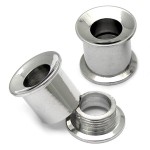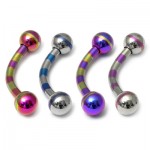Famous for it’s glittering stainless steel top, the Chrysler building is made from the same material used for body jewellery?
 Well, not quite. Although both are made from stainless steel, body jewellery is made from surgical stainless steel. So what’s the difference between stainless steel and surgical stainless steel?
Well, not quite. Although both are made from stainless steel, body jewellery is made from surgical stainless steel. So what’s the difference between stainless steel and surgical stainless steel?
There are approximately 200 types of stainless steel, although only about 15 grades are commonly used. There are two types of surgical steel called ‘316L’ and ‘316LVM’; this refers to the specific grade of stainless steel. You should only buy body jewellery made from surgical steel grades 316L or 316LVM.
 The medical profession uses instruments made of surgical steel as it’s strong, easy to clean and sterilise and is non-corrosive. 316L and 316LVM grades of surgical steel are used for temporary (in some cases up to 30 years) implants. Permanent implants are more commonly made from titanium.
The medical profession uses instruments made of surgical steel as it’s strong, easy to clean and sterilise and is non-corrosive. 316L and 316LVM grades of surgical steel are used for temporary (in some cases up to 30 years) implants. Permanent implants are more commonly made from titanium.
316L and 316LVM surgical steel is ideal for making body jewellery as it’s non-corrosive, scratch resistant and can be polished to an attractive mirror-like shine.
For body piercing jewellery to conform the migration limit (nickel release rate) must be less than 0.35µg/cm2/week.
So for piercing jewellery that’s less than 0.35 micrograms of nickel released, per square centimetre, over a 1 week period.
For further information regarding the nickel release rate and how TDi’s body jewellery conforms to EC Nickel Directive 1907/2006 REACH Annex XVII, Item 27. Click here.
Surgical Steel is ideal for healed piercings and complies with the REACH regulations for use in fresh, unhealed piercings. However, TDi Body Jewellery would recommend piercing with Titanium as a superior metal for unhealed piercings.
View 316L surgical steel body jewellery here.
